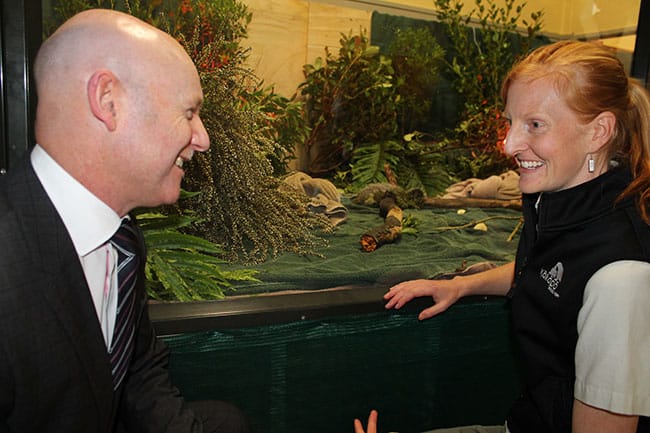BY ALLISON BECKHAM AND PETRINA WRIGHT
Southlanders are flocking to view kakapo chicks, and the opportunity has even attracted visitors from further afield. The Department of Conservation’s (Doc) Invercargill kakapo rearing unit has been temporarily relocated to a vacant building on Esk St West donated by the Invercargill City Council. Upstairs, the smallest chicks are kept warm in incubators, moving to cooler rooms as they grow.
Downstairs is the public area — a viewing enclosure and displays about the native parrots and the recovery programme. Just under 200 people visited on the first public viewing day on Sunday, Doc kakapo partnerships ranger Julie Futter said. ‘‘It went fantastically well. The response was really good.’’ Ticket sales for the rest of the month were steady, she said. Most had been to Southlanders, but one woman from Auckland was also coming. ‘‘She emailed me and said she was about to book her flights… It’s great people are taking advantage of the opportunity while it is available.’’ Kakapo are very slow breeders and chicks hatch only every second or third year.

Feathered friends: Department of Corrections chief executive Ray Smith and Department of Conservation senior kakapo ranger Jo Ledington view kakapo chicks in the new Invercargill CBD kakapo rearing unit last Thursday. Photo: Petrina WrightKakapo are among the world’s most critically endangered birds. Doc senior kakapo ranger Jo Ledington said there were 123 adults alive, 58% of which had been hand reared. The kakapo rearing unit reared youngsters until they were old enough to survive when returned to their island sanctuary homes in Foveaux Strait, Dusky Sound, Fiordland and Little Barrier Island, north of Auckland. This breeding season, 46 chicks had hatched and 36 had survived, which was the best breeding season since the recovery programme began 25 years ago, she said. Ms Ledington said the unit had been located in a warehouse lined with plastic walls which had been a miserable environment for staff to work in. Earlier this year, Doc was asked to move out and staff looked around for a new location. The Esk St West building had been pretty much derelict when Doc took it over, but had since been refurbished with help from offenders on community work sentences. ‘‘Staff are much happier with the fit for purpose building. We couldn’t have achieved this without the help from Corrections,’’ she said. Corrections Southland/Central Otago district manager Glenn Morrison said in a statement the offenders were proud to have been involved in such an incredibly significant project, which had also provided them with employable skills and experience. ‘‘It’s not just the kakapo… getting a new start through this project.’’ Corrections chief executive Ray Smith, who visited the facility last Thursday, said there were more rehabilitative effects and higher attendance rates for offenders who worked on projects in the community they lived in, projects that others were proud of, and projects in which they were able to use their trade qualifications.

Cute: A kakapo chick at the newly completed rearing unit. Photo: Allison BeckhamStory republished courtesy of Southland Express

